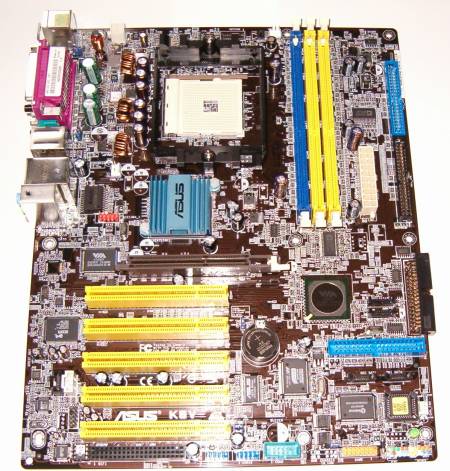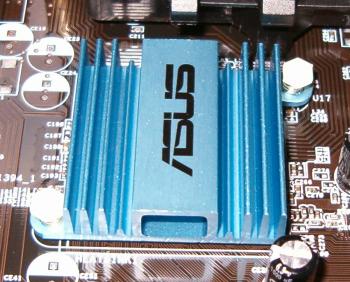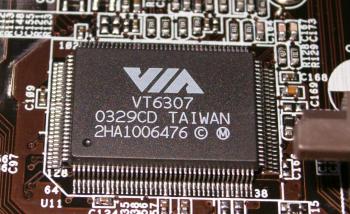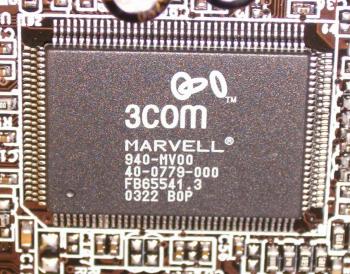Layout

As usual, I'll start in the top left as you look at that picture and work from left to right, top to bottom. From the ATX I/O ports on the top left, the first thing you hit is the three-phase power circuitry for the CPU. Analog Devices, the providers of the audio solution on the K8V, get ASIC duty for the power hardware, with a 3166 controller and 3418 gate drivers. I won't pretend to know what they do and I'll go with LostCircuits' conclusion that they'll provide clean power to the CPU. The auxilliary four pin ATX 12V supply connector is at the very top left of the board, above the power hardware. It's a decent place for it, better than underneath the socket near the northbridge, a position that can cause cable routing issues.
The CPU socket has the AMD specified retention bracket preattached, incase you don't have one already. Retail PIB (processor in box) CPU's have one bundled with them, so you'll more than likely have a spare if you're buying everything seperately in retail. The socket is oriented with the locking handle pointing west to east, starting at the lever. ASUS deem that optimal for their board, other vendors rotate the socket and orientate the lever north-south.
Past the socket area we have the DIMM slots. Optimal usage is blue first, then the middle yellow slot, then the furthest yellow slot. The ATX power header is next, a decent distance away from the furthest memory slot, meaning you don't have to remove a DIMM to remove or attach it. Past that are the two PATA ports from the VT8237. Flush against the right edge of the board is the best place for them, although I wouldn't mind seeing them rotated so the pins face outwards from the board edge, like the floppy port a bit further down the board.
The northbridge heatsink, a small blue aluminium affair with an ASUS logo, completes the parts in the top half of the board. No fan means no noise, a good thing indeed. The bridge itself barely got warm on either board sample, even when overclocking. I guess active cooling on K8T800 is overkill. Here's a shot.

Bottom half of the board now, from the AGP slot down. The slot itself has a fiddly AGP retention mechanism that I simply can't warm to recently. I've been using cards with big heatsinks, they invariably get in the way of using it to remove the card. I prefer a flexible retention mechanism like DFI use. Being a five PCI slot design, the AGP slot sits far enough away from the DIMM slots that you don't need to remove the graphics card to get access to the retention tabs on the slot ends.
The VT6307 FireWire controller sits to the left of the AGP slot.

There's a VT8237, 8237 SATA ports and floppy port sandwich, right next to PCI slots one and two.
The 3C940 LOM controller is next to PCI slot two, with the AD1980 sound chip near the left board edge, by PCI slot four. Here's the 3C940 in all its splendour.

As far as the rest of the layout goes, I'd have preferred the Promise PATA port rotated north-south and the Promise SATA ports stacked on top of each other, like the 8237 ports are, but it's nothing bad. SATA cable length means as close to the right edge of the board as possible is the best placement, so ASUS do well enough in that regard.
The WiFi card port is the last notable feature, it sits under the last PCI slot. Want to see it installed? Click here (~40KB).
All in all, a decent layout. The ATX power connectors are in good places, the SATA ports are where they should be, along with good placement on the PATA ports (8237 provided at least), there's room between AGP and the memory slots and all the feature providing hardware is present and correct. My only gripe is with the AGP retention mechanism, but if you aren't swapping graphics cards at least a couple of times a week, who cares?
Aesthetics wise, it's a brown colour, what more can I say about that? The port colours serve no tasteful purpose and are simply coloured that way for identification. It's no DFI LanParty, that's for sure.
Ah, one last thing, the case headers are very well labelled and different colours too. Anything that helps you identify that proprietary mess of pins is a godsend. Thankyou ASUS for that.









